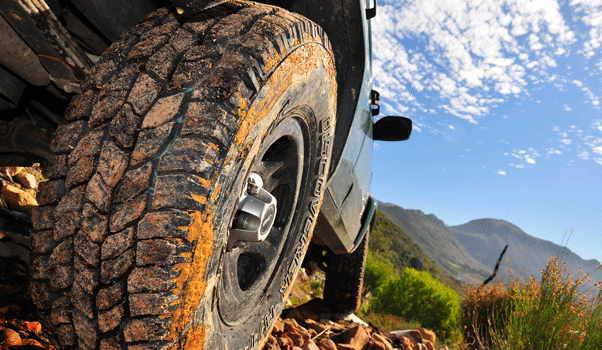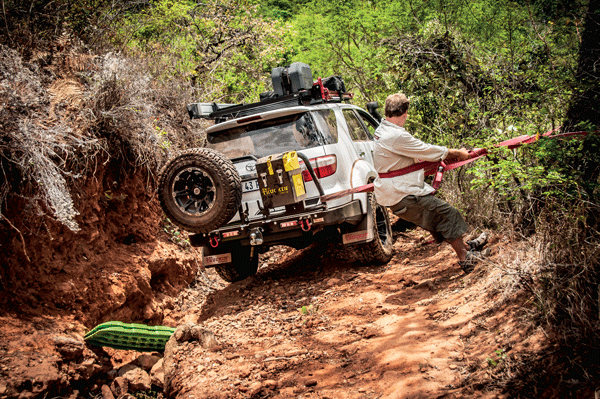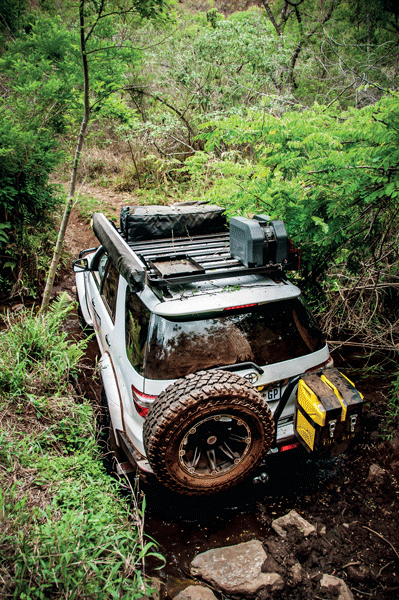Whether you approach the complex topic of tyre deflation as a science or an art, there are some guidelines all off-roading enthusiasts should follow.
Grant Spolander explains
Many years ago, I was testing the performance of a Ford Ranger against a Toyota Hilux. The first obstacle we faced was a steep and twisty track forged through deep sand. It was particularly hot, which made the sand softer and that much more challenging.
With the tyres set to 0.8 bar pressure, neither vehicle could make it to the top of the climb. We tried a dozen times at various speeds; but, no matter how fast we charged that hill, we could not get more than 30% of the way up.
Finally, in an act of desperation, we dropped the tyre pressure on both cars to 0.6 bar. Before we knew it, we were cruising to the top at an effortless pace. The transformation in performance was indescribable – and all we’d done was lower the tyre pressure by 0.2 bar.
No matter what 4×4 you own or how extensive its list of off-road gadgets may be, driving aids such as traction control, terrain response and diff lock mean very little in the absence of tyre performance or – more specifically – traction.
Besides tread design, tyre pressure is the most vital factor when it comes to traction. Failure to deflate one’s tyres to suit a specific terrain will not only reduce a 4×4’s off-road performance, it will drastically increase the risk of harm to both tyres and environment.
The increase in performance that comes with deflating a vehicle’s tyres is linked almost exclusively to the increase in tread length as the tyre deflates, not tread width. In other words, you want the tread to stretch out in length, not to bulge at the sidewall. The tread is the strongest part of a tyre and can be repaired when damaged. In contrast, the sidewall is a tyre’s weakest and most vulnerable area and can’t be repaired.
Unfortunately, with a near-infinite number of terrain types out there, it is not easy deciding which pressure is best for the occasion. This situation is further complicated by other variables, such as vehicle mass (including payload), tyre size (larger tyres need more deflation) and tyre construction. Then there are fluctuations in pressure to consider; a factor influenced primarily by heat and rising road temperatures during the day.
Generally speaking, loose surfaces (such as snow, mud and sand) require lower tyre pressures than firm surfaces (such as rocks, gravel and clay). The table on the right serves as a rough guide for adapting vehicle tyre pressures to suit various terrain types. But, bear in mind that this is just a guideline, as it doesn’t take into account the aforementioned variables, which may differ on every outing you make.
In the end, tyre deflation is perhaps not a science, but an art best mastered through a process of trial and error.
DEFLATION TIPS
• The manufacturer’s recommended tyre pressure is usually accurate for on-road use. Look inside your vehicle’s fuel flap or door recess, or in the owner’s manual for a tyre-pressure chart. Most manufacturers recommend 2.2–2.4 bar for a 4×4.
• Ensure you travel with an accurate tyre-pressure gauge, heavy-duty compressor and puncture-repair kit in your 4×4 at all times.
• Always deflate your tyres when driving off-road. It’s safer, more comfortable and far less harmful to the environment.
• Never underestimate the impact of a small change in tyre pressure. It can drastically improve your vehicle’s gravel-driving performance and road comfort – especially over corrugations.
• No matter what the terrain type, never drive on a deflated tyre at high speed. Doing so will cause excessive heat within the tyre, along with irreparable damage and ultimate tyre failure.
• Never perform a sharp turn if your tyres are deflated below 1.2 bar. Doing so will place pressure on the tyres’ sidewalls and may cause them to de-bead (pop off the rims).
• Your 4×4’s rear tyres can be deflated slightly more (about 0.2 bar) than its front tyres, as they are not subjected to turns and sidewall pressure.
• When driving over sharp rocks, stop deflating your tyres the moment they start to bulge at the sidewalls.
• As a general rule, you should never go below 0.8 bar when driving over rocks on an HT (highway terrain) tyre.
• Always drive over sharp obstacles rather than trying to squeeze around them.
• Beware if your deflated tyres take on a bluish tone – it means that they are underinflated and overheating.
TYRE CONSTRUCTION
How a tyre is built greatly influences how it will react to deflation. Some tyres use a robust rubber compound that requires additional deflation in order to achieve the same stretched-out result. Moreover, a road-biased HT (highway terrain) tyre with a two-ply sidewall rating will need less deflating than an AT (all-terrain) or MT (mud-terrain) tyre constructed with a three-ply sidewall.
Grab your calculator
Use these figures as a guide to inflating your tyres, depending on the different terrain types.
Tar: 0% deflation (manufacturer’s recommendation)
Gravel: 10–15% deflation
Corrugated dirt track: 10–15% deflation
Sharp rocks: 10–15% deflation
Smooth rocks: 20–50% deflation
Mud: 25% deflation
Sand: 50–60% deflation
Photography Grant Spolander
(This article was first published in the autumn 2015 issue of AA traveller magazine)






